1. Why AI is Changing the Landscape for Restaurants
The hype around AI in everyday business isn’t just hype—it’s a genuine disruptive force that’s shaping brand-new possibilities. Restaurants that embrace a Smart delivery app with AI stand to gain significant advantages that go beyond mere speed. These Intelligent food delivery solutions, powered by machine learning algorithms, can suggest better routes, predict inventory needs, or even craft personalized meal recommendations. Essentially, these advanced capabilities lead to fewer delivery hiccups and better engagement, which in turn translates to more loyal customers.
You might wonder, how do AI-driven solutions accomplish this goal so effectively? The answer is that AI taps into historical data patterns and real-time analytics. By gathering and analyzing data [like traffic conditions, weather updates, and consumer preferences], your AI-powered food app features become more adept over time, systematically refining the customer’s journey from the moment they browse the menu to the minute the food arrives at their doorstep. That’s the true hallmark of a Smart delivery app with AI: continuous improvement.
2. Setting the Stage: Why Build a Food Delivery App Now?
We’re in an era where convenience tops everything else. Surveys indicate that a large share of diners routinely turn to mobile apps when they want a quick lunch or dinner. From the business side, a dedicated Food delivery app for restaurants reduces the reliance on third-party aggregators that often take a substantial commission. When you Build a Food Delivery App under your brand’s name, you maintain control over how you present your menu, how you manage promotions, and how you communicate with customers.
And there is another attraction: brand loyalty. If a customer trusts your restaurant, they’re far more likely to download your standalone solution rather than pick from the dozens of aggregator apps crowding the marketplace. A direct connection fosters a sense of exclusivity and reliability. Plus, with built-in loyalty programs, timely push notifications, and dedicated customer service, you can encourage repeat business organically. Actually, more than half of users who have a positive first-app experience will continue ordering from the same place, which underscores the value of investing in a solution that customers love from day one.
3. Core Restaurant Delivery App Features
Let’s tackle the basics. Before we even talk about advanced AI capabilities, you need to make sure the fundamental Restaurant delivery app features are in place. These features create a baseline user experience that can then be augmented with AI-driven functionalities. Below are the key building blocks:
- User-Friendly Interface: A neat, intuitive design that lets customers quickly view menus, prices, and special offers. Nobody wants to jump through hoops to place an order.
- Seamless Registration and Profile Creation: Options to sign up via email or social logins. A frictionless onboarding experience prevents users from abandoning the process prematurely.
- Real-Time Order Tracking: This is essential for any modern app. People love to know exactly where their food is and how long they have to wait.
- Secure Payment System: Ensure safe, encrypted transactions. Offer multiple payment choices [such as credit cards, debit cards, e-wallets] for added convenience.
- Push Notifications: These keep users updated about special offers, loyalty points, and order status. Timely reminders also help boost engagement.
- Reviews and Ratings: A transparent review system instills confidence and fosters trust. It also helps you collect feedback for ongoing improvements.
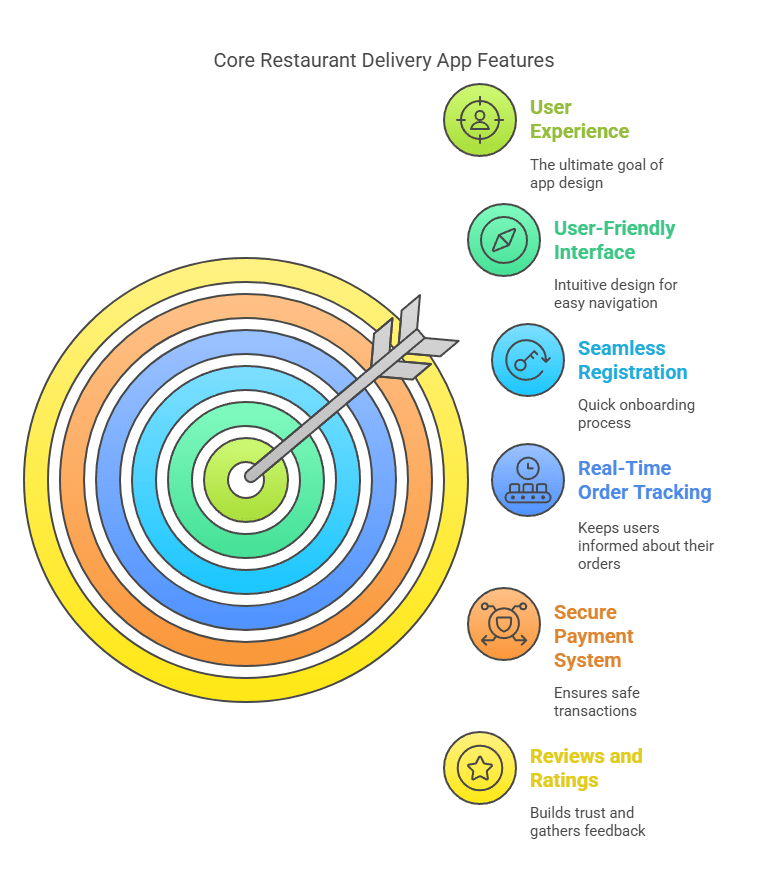
Once these fundamentals are covered, you can build on them further. For example, many businesses choose to add custom promotions or dynamic discounts, which can be scheduled or triggered during off-peak hours to keep operations humming. From there, the jump to AI-based personalization is relatively straightforward.
4. Integrating AI-Powered Food App Features
To Build a Food Delivery App that resonates with today’s fast-paced market, weaving in AI is more than just a cool trick—it’s a necessity. AI-powered food app features help automatically refine marketing strategies, improve delivery routes, and deliver tailored user suggestions based on purchase history. Let’s explore a few prime examples:
- Smart Order Management: By analyzing trends [like popular dining hours], your application’s AI component can forecast order volume, optimally schedule staff, and recommend dynamic menu pricing. Essentially, the system “learns” from previous patterns to help you make real-time decisions.
- Route Optimization for Drivers: One of the biggest cost drivers for restaurants is inefficient delivery routes. AI can factor in traffic data, road closures, and weather updates, then plot the fastest path. This leads to improved efficiency and cost savings.
- Personalized Recommendations: Do you know how e-commerce sites offer curated product suggestions? A Build AI food app can do exactly that—suggesting items based on a user’s personal history. Think of it like a gracious host who already knows what you like.
- Chatbots for Customer Service: Bots may not replace human warmth entirely, but they can handle routine inquiries and direct customers faster than manual systems. That means your support team can tackle more complex issues without getting bogged down.
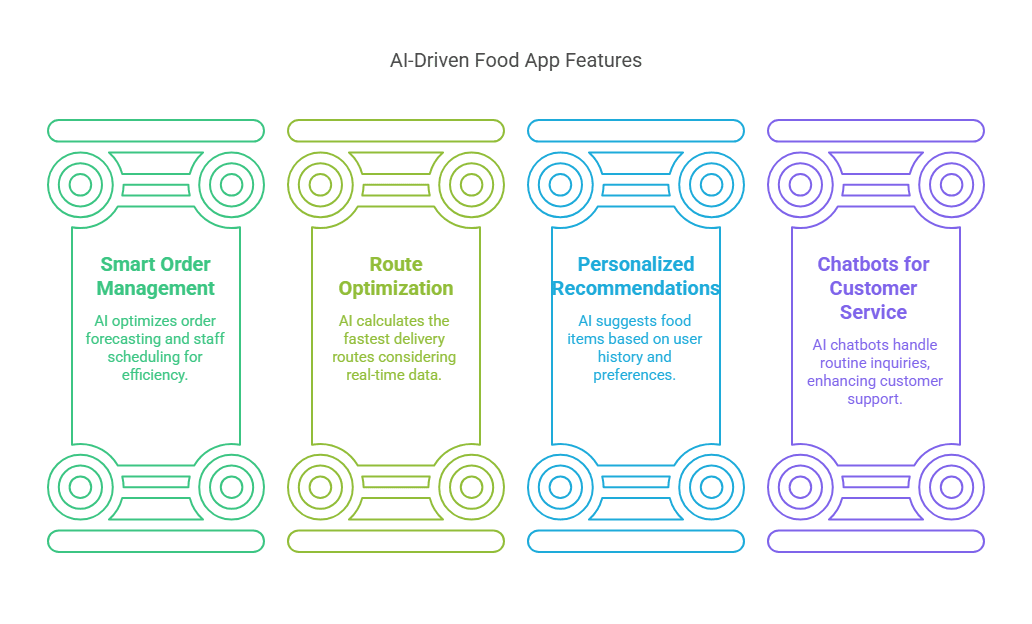
A Quick Digression on Data Handling
One lesser-known consideration: the explosion of AI-based features also means an increase in data collection. Ensure you have the right data management and privacy measures in place. With restaurant apps, you’re often handling sensitive credit card information, user contact details, and potential location data. Data security is paramount. Remember, a single data breach can seriously harm your restaurant’s reputation.
5. Intelligent Food Delivery Solutions in Action
Let’s demonstrate how Intelligent food delivery solutions show their worth. Suppose you run a mid-sized chain with multiple outlets across a major city. During peak lunch hours, your system sees large spikes in orders, typically from corporate offices. Using AI, your management dashboard might automatically allocate more deliverers to those high-demand zones. Closely coupled with real-time tracking, you can promise—and deliver—faster drop-offs.
That’s not all. Because you gather data around common orders, meal combos, and tipping patterns, you can identify which segment of your menu is most profitable at which time. With advanced analytics, you might notice that your vegetarian options are big sellers on Mondays when health-conscious behavior peaks, prompting you to highlight those items at the top of the app’s menu for more visibility. It’s the difference between tossing random promotions at customers and presenting them with curated suggestions that genuinely align with their preferences.
6. Step-by-Step Guide: How to Build AI Food App Systems
If you’re eager to Build an AI Food App from scratch, or you want to retrofit your existing system with Intelligent food delivery solutions, here’s a simplified plan to keep your project organized:
- Define Your Key Objectives: Are you trying to minimize delivery times, expand your reach, or personalize user interactions? Clear goals will direct the type of AI models you choose to integrate.
- Scope Out Essential Functionalities: This is where you circle back to the core Restaurant delivery app features, ensuring the fundamentals (like ordering and payment) are rock-solid. Decide which manual processes should be automated.
- Select the Right Tech Stack: For AI-driven solutions, you’ll likely need frameworks like TensorFlow or PyTorch. Consider whether you want a cloud-based infrastructure. Make sure to choose a scalable backend, so you don’t outgrow your platform.
- Integrate AI Modules: Start simple with route optimization or demand forecasting. Then, build upon these modules to create advanced personalization and chatbots. It’s best to get one feature rock-solid before moving on to the next.
- Test and Iterate: AI is only as good as the data you feed it. Once integrated, thoroughly test each feature in real-world conditions. Keep refining based on user feedback and new data. This ongoing cycle ensures continuous improvement.
- Protect User Data: Don’t skip investing in robust encryption, multi-factor authentication, and compliance with laws like GDPR. Data security can’t be an afterthought.
- Deploy and Optimize: Gradually roll out your solution. Use analytics dashboards to track key metrics (average delivery times, user satisfaction, etc.). Adjust features and scaling as usage grows.
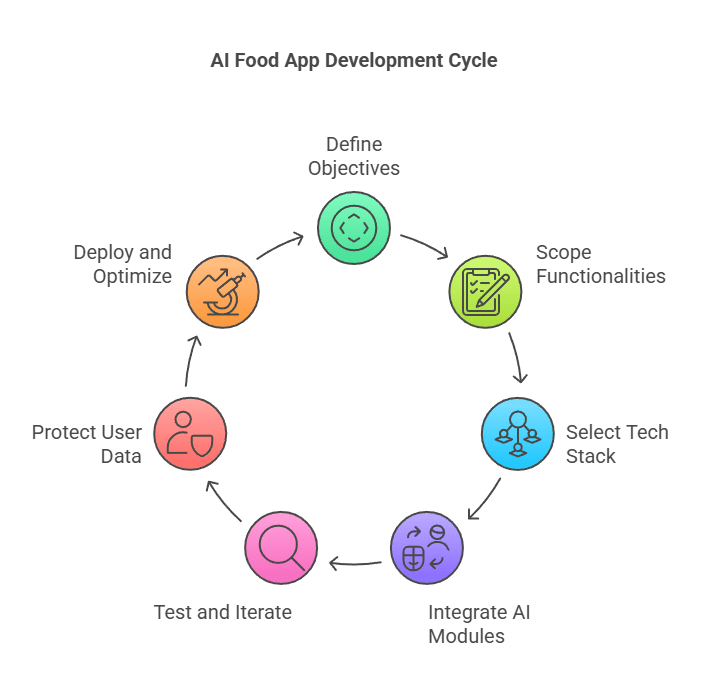
Throughout these steps, maintain a user-centered perspective. High-tech features won’t mean much if your customers struggle to place an order or find the interface confusing.
7. Overcoming Implementation Challenges
On your journey to Build a Food Delivery App with AI functionalities, you’ll likely face some obstacles:
- Data Quality: Poorly labeled or insufficient data restricts your AI’s ability to learn. Ensure you collect accurate user data that you can feed into your algorithms.
- Integration Hurdles: Tying new AI modules into an existing architecture can lead to compatibility issues. Plan carefully to avoid disruptions to ongoing operations.
- Cost Management: AI can significantly elevate the project’s total budget, especially if you need specialized developers. Identifying the critical features to develop first helps control these costs.
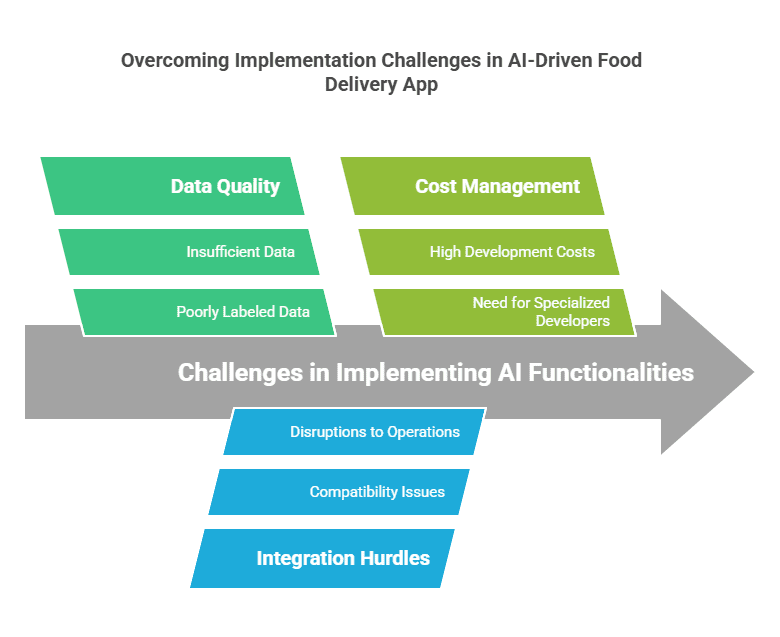
Here’s one practical tip: start with a smaller pilot. If you own multiple restaurant sites, pick one location to test your new app features, gather feedback from real users, and refine the system before you roll it out to all locations. This pilot-phase approach can save you time, money, and potential embarrassment. And keep in mind that AI thrives on iteration—your system’s performance will keep improving as long as you feed it fresh data and refine your algorithms.
8. Key AI-Driven Features and Their Impact
Below is a table summarizing several high-value AI-driven features you might consider when you Build a Food Delivery App. Keep in mind that each feature serves a distinct purpose, so choose based on your strategic goals.
| AI Feature | Description | Benefit |
|---|---|---|
| Route Optimization | Analyzes traffic and weather data to suggest optimal routes | Cuts travel times and fuel costs, leading to quicker deliveries |
| Demand Forecasting | Predicts order volumes by analyzing historical patterns | Prevents under/over-staffing, improving resource allocation |
| Personalized Menus | Recommends dishes based on user preferences and buying history | Enhances engagement and boost upsells |
| Chatbot Assistance | Manages routine customer inquiries 24/7 | Reduces burden on customer support staff |
| Dynamic Pricing | Adjusts menu prices in real-time based on supply and demand insights | Maximizes profit margins and manages inventory effectively |
9. Common Misconceptions About Building an AI Food App
Some business owners shy away from advanced technology because they assume it’s too expensive or complicated. That’s partially understandable—AI implementation can feel overwhelming. However, one misconception is that you need to be a tech wizard to start. In reality, you can collaborate with a skilled development partner to handle the nitty-gritty.
Another mistaken assumption is that AI will solve all your operations headaches automatically. Let’s refine that statement a bit. AI refines efficiency, but it still requires consistent oversight and data calibration. If drivers are ignoring route suggestions or if your staff neglects analytics reports, you’ll end up with incomplete results. Think of AI as a sharp tool that still needs direction and skillful handling.
10. The Business Edge: Benefits of a Smart Delivery App with AI
Creating a Smart delivery app with AI injects a whole new dimension into the market. Not only do you stand out among competitors, but you also provide users with a level of convenience they quickly come to expect. Consider some of the direct benefits:
- Stronger Brand Identity: Having your own platform gives you full control over branding, visuals, and promotions. Third-party platforms typically limit your creative freedom.
- Reduced Costs Over Time: Although the initial build can be significant, the efficiencies you gain—like route optimization and targeted advertising—often offset the upfront investment.
- Enhanced User Engagement: Personalized notifications, thoughtful promotions, and chatbot support keep users hooked. And the more they interact, the better your AI learns about them, fueling a virtuous cycle of improvement.
- Valuable Data Insights: You are no longer in the dark about who your customers are or what they love the most. Data analytics can reveal hidden trends that traditional guesswork might miss entirely.
- Scalability: With the right cloud-based architecture, your solution can handle large spikes in orders. That’s key if you operate multiple locations or plan to expand.
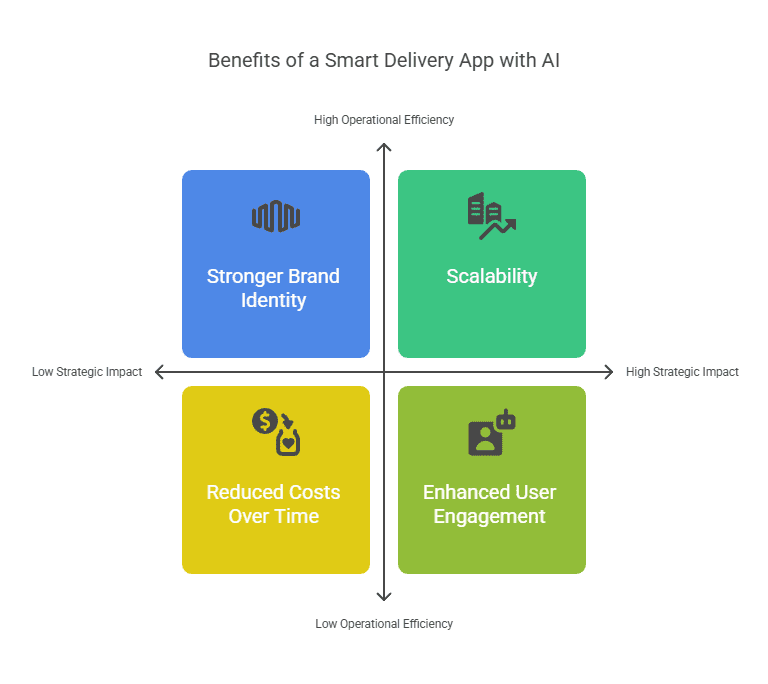
11. Addressing Less Obvious Considerations
Here’s one that’s sometimes overlooked: content and language localization if you plan to expand internationally. Building an app that easily accommodates multiple languages, currencies, and even local menu variations is crucial for growth. AI also has a role here—some intelligent systems use natural language processing to tailor chatbot interactions in different tongues, bringing you closer to new segments of potential customers.
Additionally, do keep training costs in mind. Your staff might need a bit of time to adjust to new features like AI-driven dashboards. Although the user interface can be intuitive, a formal onboarding process ensures that everyone, from delivery personnel to customer service reps, feels comfortable. I’ve found that short training videos and a simple FAQ page within the staff portal can be very effective.
12. Ensuring a Seamless Customer Journey
A truly Intelligent food delivery solution revolves around user experience. Each step in the ordering process should feel smooth and familiar:
- When a user launches your app, they see a well-laid-out homepage highlighting popular meals, special deals, or recommended combos.
- As they explore the menu, the system highlights items aligned with their taste profile. Maybe it suggests gluten-free options for them if they recently browsed those categories.
- Once they confirm an order, real-time tracking and notifications assure them that everything is on schedule.
- If they have concerns or want to add an extra topping at the last minute, a chatbot is around to help. For more complicated queries, a human agent can jump in.
The net effect is a positive emotional experience, making the user feel like you crafted everything just for them. And that is worth a ton in today’s competitive environment, saturated with multiple aggregator apps vying for attention.
13. Looking Ahead: Future AI Innovations
The field of AI isn’t static. Emerging tech like computer vision could soon evaluate the quality of prepared meals, or advanced sensor data might help maintain ideal delivery conditions [hot or cold boxes]. You can expect restaurant technology to keep evolving, so building an infrastructure that’s flexible and integration-friendly is key.
There may come a time when drones or autonomous vehicles become a real possibility for certain territories. While this might seem futuristic, it’s worth keeping your architecture open to such transitions. If your system can seamlessly integrate new delivery methods, you’ll stand at the forefront of cutting-edge innovation.
14. Putting It All Together: How to Move Forward
If you want to Build a Food Delivery App from the ground up and infuse it with AI from day one, begin by gathering a team that truly understands the restaurant domain as well as the tech dimension. If you already have an app, weigh the cost-benefit of upgrading it with AI modules. Typically, the benefits of improved operational efficiency and better user experience make a strong argument in favor of upgrading.
Remember to keep an iterative mindset. Launch a minimal viable product [MVP] that includes the essential Restaurant delivery app features plus one or two key AI functionalities, such as route optimization or demand forecasting. Then, gather feedback, refine your approach, and add new intelligent features. Over time, your system will grow. That’s precisely how you transform a basic ordering platform into a robust, AI-powered food app that meets—and surpasses—customer expectations.
One Thoughtful Aside
And if you’re feeling a twinge of uncertainty, that’s perfectly normal. Many restaurant owners are so accustomed to third-party services that the idea of a dedicated solution seems daunting. But a well-executed Best-of-Breed approach—where you bring in specialized experts for each component—can substantially lighten the load. One day, you’ll look back and wonder why you didn’t embrace your own Intelligent food delivery solutions sooner.
15. Conclusion
Building an advanced delivery platform might sound like a tall order at first, but once you break it into manageable steps, it becomes a realistic venture. When you Build a Food Delivery App that’s AI-enabled, you’re not just offering another online ordering tool: you’re cultivating valuable customer relationships and data-driven insights that accelerate your restaurant’s trajectory. The results are tangible—happier customers, optimized operations, and a brand image that feels relevant and modern.
Ultimately, technology is the enabler, not the end goal. Your app should serve the mission of your restaurant and its patrons. Keep your core objectives [speed, quality, personalization] front and center, then design each feature around fulfilling those objectives in the most efficient manner possible. By using a phased approach, focusing on data integrity, and iterating as you gain real-world feedback, you’ll be well on your way to a truly game-changing platform.
So, is it time for you to take the leap? If you’re nodding, that’s a good sign. The immediate payoff might be streamlined deliveries and higher check averages, but the long-term benefit is something deeper: a fresh sense of confidence that your business can adapt, innovate, and thrive in a rapidly changing digital environment.
About the Author
I’m one of the senior copywriters at Blocktech Brew, where we specialize in guiding businesses through cutting-edge solutions [including AI, blockchain, and more]. We’ve helped numerous clients Build AI food apps with route optimization, dynamic order management, and other AI-powered components. Whether you’re a startup or an established brand, we’re here to help you craft an intelligent Food delivery app for restaurants that translates into real business results. Feel free to reach out if you’re ready to start the brainstorming or want a deeper chat about strategy.
Above all, remember that the journey to Build a Food Delivery App is a dynamic one: every feature you adopt and every AI upgrade you make refines your edge in the marketplace. With a thoughtful plan and a willingness to embrace new technologies, you can grow a solution your customers love—and keep them coming back for more. And that, in a nutshell, is how you pave the future for restaurant delivery success.






